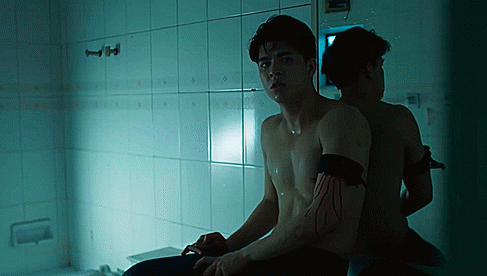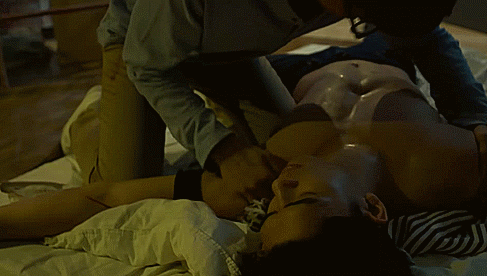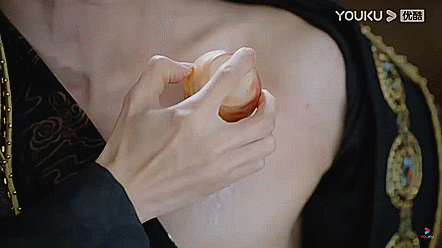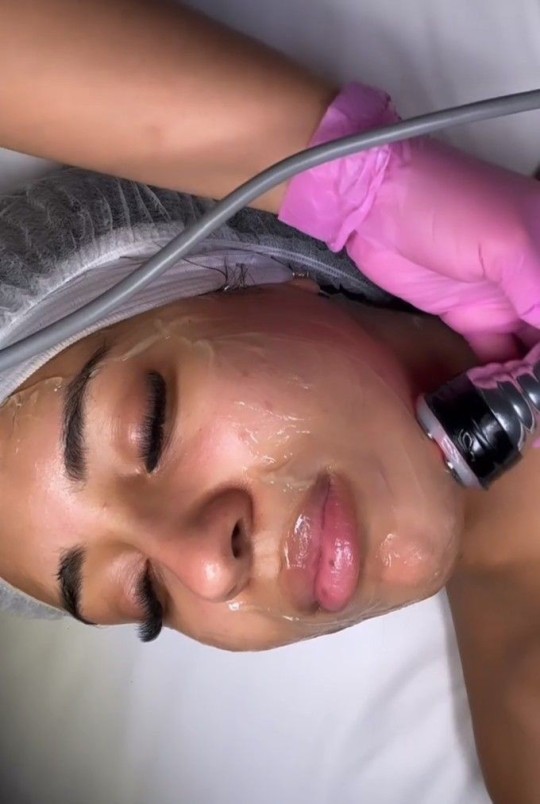#self treatment
Text








3 Will Be Free - Ep. 9
#3 will be free#thai drama#gunshot wound#on the run#bleeding#blood loss#bloody hands#dizziness#stumbling#self treatment#field medicine#bandages#makeshift bandages#collapse#passing out#collapse into arms#concern#unconscious#hugging#crying#tay tawan#joss wayar#whump#thai whump#asian whump
73 notes
·
View notes
Text
Character A freaking out a little (or a lot) about Character B's dislocation but B is hypermobile and their reaction is basically just "This again?" 🙄 before popping it back in
337 notes
·
View notes
Text
So, pretty much all of Danmachi season 4 feels like one giant Hurt!Bell fest. But this gem from episode 18.... holy mother of gawd~~~
#whumperflies#whump#anime whump#danmachi#is it wrong to try to pick up girls in a dungeon?#bell cranel#stabbed#poisoned#self treatment#so much screaming
170 notes
·
View notes
Text
TW: needle
“Do I have to do it?” A sniffles, holding the syringe in a quaking hand.
“Yes A. You have to. It’ll be over quickly once you’ve done it,” B attempts to reassure from their vantage as a little rectangle on the screen of A's phone.
“Can’t you do it like you always do?”
“A, I’ll be back before next time but I really need you to do this for me otherwise things will get a whole lot worse.”
“I know,” A sniffles again, trying to take deep breaths like B instructed.
“I’ll count to five and then you need to dart it in, okay? Take some deep breaths. It will all be over soon,” B instructs, “One… two… three… four… five–”
“I CAN’T DO THIS!” A wails, flinching away at the last second.
29 notes
·
View notes
Text
"I can't do this" + self treatment
@whumpril day 17
Hero and sidekick
Warnings: mild gore, inaccurate medical care
300 words
---
Sidekick backs away from Hero, her hands shaking just inches above Hero’s torn-open forearm.
“Sidekick…” Hero says weakly, “You alright?”
She shakes her head and pulls her hands back, wrapping them around herself, “No, no. I’m sorry, I can’t do this. I just–I can’t.”
She shakes her head rapidly and paces around Hero, he nods and uses his good arm to stop her. “That’s alright. What I need you to do is go get the first-aid kit from under my bed. Alright? The one from your car isn’t gonna have what I need.”
“Oh,” Sidekick says. She nods and walks out of the kitchen, muttering, “I can do that.”
Hero waits for the bathroom door to close before resituating himself. He angles his arm toward himself and takes the tweezers out of the rubbing alcohol. With a sharp exhale, Hero plunges the tweezers into the wound and digs out a sliver of wood. He grunts and stomps his leg on the ground before pulling the tweezers back out and dropping the splinter on a folded up paper towel. He repeats the process until there’s nothing else in his wound.
He sets the tweezers on the paper towel and leans back on the toilet seat. He exhales slowly and reaches for a towel from the cabinet.
Just as Hero presses the towel on his arm, Sidekick runs back into the room, first-aid kit in hand. “Got it!”
She stares at him, follows his arm to the wound, “Oh.”
Hero sighs and reaches for the kit, “Thanks.”
“You tricked me!” she exclaims. She sways when the blood seeps out from the towel and trickles onto the bathroom counter. “Thank you.”
Hero nods and clicks the kit open, digging through it for gauze bandages. “You need to drive me to the hospital though.”
#em writes#em writes stuff#my writing#whump#whump fic#whump writing#whumpril#whumpril2023#whumprilday17#hero whumpee#sidekick caretaker#hero whump#field care#i can't do this#self treatment
13 notes
·
View notes
Text
Whumpril Day 17: Cry For Help/Self Treatment/"I Can't Do This."
Fandom: Star Wars The Bad Batch
Warnings: Spoilers for the last episode of season two, character injuries.
Note: If you want more from this story I will write it! Don't hesitate to let me know! No beta reader we die like Mayday
Summary: Tech survives the fall and now he's gotta live past just the fall.
Tech had calculated the chances of surviving the well over 1,000 foot fall. They were less than 1% but he didn't care. There was no time and he needed his family to make it back alive. They all had bright futures ahead of them and they needed to bring Crosshair home. He didn't hesitate to shoot the remainder of the metal connecting the car. Then he fell. It took around 50 seconds.
Then he woke up. Tech was in agonizing pain but he was alive. He heard voices around him. Then they were gone. The clone felt like he couldn't move. The slightest movement was simply too much pain to bear. However he needed to.
Attempting to move his right arm he came to the conclusion he couldn't. The man moved his left fingers, then hand, then wrist. Screaming in pain he pushed himself slowly up to lean against the remainder of the rail car. If it had landed on him he would have been unrecognizable.
Tears flower down his face and cough in lacerations. The liquid mixed with blood. Tech forced his head up and looked at his body. His left leg was practically destroyed. His right was salvageable. The bones in his salvageable limbs had multiple breaks in them. Tech could already tell there were multiple breaks in his back as well. However they didn't affect his ability to move so none of them affected the spinal cord.
Looking at his torso he was overwhelmed. It was hard to see through the blood. He was covered in larger and smaller gashes.
'I can't do this.' the thought flashed through his head. 'I can't do this. It's too much.' Tech's breathing was shaky and uneven. His vision was blurry from a mix of his injuries and the lack of his goggles.
'You have to it. It is possible' the more logical thought took over his mind. Determination had to beat pain, it had to. His head and heart had to battle his body. 'For them.'
Tech tugged at the top of his right pouch and opened it. His hissed and grabbed the little medical supplies inside. Looking over at the other legs pouch he decided it was worth a try.
Nothing was usable from that side. All the supplies were demolished. That was the pouch that he kept little items to comfort his family with. A small, soft piece of fabric, as well as a pair of earplugs for Hunter, tooth picks for Crosshair, a small, 3-D puzzle for Wrecker, a pocket sized reg manual for Echo, and a small clone trooper doll for Omega. He also kept three hair ties; all black, just in case some one needed them.
Wrapping the largest and most threatening wound took a large amount of time and energy. By the end of it Tech was exhausted.
The sun was mostly gone at that point. He started to hear voices from somewhere around him. Unsure of what else to do Tech pushed himself to speak. "Help" he whispered, desperately.
No one heard him. "Help" Tech's voice broke as he spoke at his normal speaking level. He tried again and no real sound came out.
"Help!" He screamed. The voices grew closer. With all his strength Tech called out again, "help!"
A tall, blue Twi'lek walked over cautiously followed by a black Wookiee, a teenage, human boy, a; if Tech had to guess clone, and a rather short Rodian.
"Come on, we have to help him." The human child spoke. He walked beside the injured clone and kneeled down, "he'll die if we don't."
The Twi'lek looked over to the clone beside her, "do you recognize him? You look surprised."
"No, but I know someone's gonna be missing him. Grawarr, grab him." The Wookiee walked over and gently picked up Tech. He screamed in pain as he was being picked up. Grawarr hummer softly, as if to apologize.
The six made their way back to the village that was around an hour away. The pain forced tears out of Tech's eyes. He slipped unconscious about ten minutes into the journey. He was safe for now. He would need to heal and then find his way back to them and he wouldn't stop until he did.
@whumpril
#star wars#star wars whump#whump#star wars the bad batch#tech needs a hug#tech whump#tech the bad batch#tech bad batch#tech#post season 2#Post Plan 99#Whumpril#whumpril 2023#Whumpril day 17#cry for help#i can't do this#self treatment#good luck buddy#part 2?#oh look OCs#thats new#Tech tbb#Tbb#no beta reader we die like the clones#hehe parallels
14 notes
·
View notes
Text
@whumptober #13: Dislocation
Fandom: Marvel (Spider-Man: No Way Home)
Characters: Peter One (Tom Holland), Peter Two (Tobey Maguire), Peter Three (Andrew Garfield)
~
“I know I ask you this every time but I’m going to ask again: are you sure you don’t want to go to a doctor for this?” Peter Two pressed.
“No. Yes!” Sprawled face down across his bed, inflamed arm dangling crookedly over the side, Peter One muffled his groan in the covers. “I-I mean yes, I’m sure that no, I don’t want to. I’m the same broke college student you guys were; I can’t burn $400 for them to x-ray my elbow, tell me what I already know, yank it and put it in a sling. You know that! Not to mention the identity risk…It’s too much.”
“The painkillers we have here at home aren’t gonna cut it for you,” Peter Three warned uneasily.
“Nnngh, I can’t imagine it feeling any worse than it already does! I-I’m sure the healing factor will take the edge off as soon as it’s back in place. And the sooner the better, right? Come on, guys, please. Let’s just get it over with!”
Against their better judgment, Two pushed as Three pulled.
It was a blessing that Peter was already lying down. What they could see of his face promptly washed white, a shrill, pitiful squeak-gasp of realization escaping as the pain registered and he went limp.
Cringing on his behalf, Peter Three shuffled his feet guiltily in the carpet. “I, uh, I’d say ‘I told you so’ but…”
Peter Two leaned gingerly to peer closer at their brother. “Yeah, I don’t think he’s conscious to hear you.”
#whumptober2022#no.13#dislocation#marvel#spider man#fanfiction#whump#self treatment#fainting#peter parker#peter two#peter three#tom holland#tobey maguire#andrew garfield#drabble
12 notes
·
View notes
Text

2 notes
·
View notes
Text




Till The End Of The Moon - Ep. 21
#till the end of the moon#cdrama#stabbed#aftermath#bleeding#self treatment#painful wound cleaning#pain#luo yunxi#whump#cwhump#asian whump
72 notes
·
View notes
Text

How to Correct Hyperflexion Syndrome Caused By Too Much Sitting
Excessive Lumbar Lordosis and Hyperflexed Iliacus muscles result in inhibition of the Glut Max and Hamstring extensors. Doing Squats to get those Gluts going will only result in overuse of your back and Quads. Before exercise to build the buttocks, it is necessary to turn the muscle "ON" or facilitate it. This can be done temporarily through direct activation techniques such as MAT or massage.
Too much sitting contributes to foreshortened Iliacus muscles. This may also be accompanied by excessive lumbar lordosis on one side resulting in an anterior tilt to the pelvis and possible Torque.
To change the body's chain of command to facilitate the hip extensors you need to reduce the tone in the back extensors first. This is easily done by using 2 balls in a sock placed in the L5/S1 junction while lying on your back with your knees up and your hands clasped behind your knee. Breathe and relax your back into the balls. Once the back has settled, begin slowly adding pressure into the restraint provided by your clasped hands. About 5 to 10 lbs is plenty. The less you do the faster your body will be able to figure out how to turn ON the Hamstrings and Gluts for hip extension and OFF the back extensors. Combine this with some regular stretching of the hip flexors and you'll be able to stand up straight again!
Sounds simple enough but ...this is actually quite difficult to accomplish and feels exhausting to the brain. Remember, the less force you use the faster your body will change.
(Neuromuscular Reprogramming)
#self treatment#Neuromuscular Reprogramming#NMR#Jocelyn Olivier#back extensors#hyperflexion syndrome#too much sitting
4 notes
·
View notes
Text
Ehem, well, this is the show that keeps on giving!!
Danmachi S4 Ep 21
#whumperflies#anime whump#bell cranel#whump#blood loss#stabbed#passes out#danmachi#is it wrong to try to pick up girls in a dungeon?#cauterized#self treatment#he's down for the count folks#so much screaming#vomiting blood#literally had to lift himself off a friggen spike
105 notes
·
View notes
Text

By Jennifer Block
Published: Nov 7, 2023
In August, a Missouri law went into effect that limits gender treatment for minors to counseling. Such laws, which have passed in 22 states to date, can be particularly cruel. Minors already on puberty-suppressing drugs or cross-sex hormones are being effectively cut off. Trans adults on Medicaid who’ve been taking hormones for years may find their prescriptions are suddenly unaffordable. And often these laws are tied to overt acts of culture war — like a ban on drag shows in Tennessee.
This wave of legislation is unfortunate for another reason. A lot of fair-minded, thoughtful people may question whether hormones and surgery are appropriate for the growing number of young people who are distressed about their biological sex. But given all the campaigns in red states, many progressives are instead biting their tongues and trusting that doctors know what they’re doing.
The problem is that as more kids identify as transgender than ever before, it’s still worth asking whether “gender affirming care” is the right model for them. Despite the certainty advocates project that this is an open-and-shut case, it wasn’t long ago that this “affirming” approach for children was simply an idea — a hypothesis informed by experience, but an idea nonetheless. Yet in less than a decade, it became standard of care and is now practically gospel in the United States, even as other countries are redirecting services toward psychotherapy and social support.
A natural response on the left to bills restricting or even outlawing gender-related medical treatment is “keep your laws off my body.” As a vocal supporter of abortion access, I’m sympathetic. But it’s a mistake to conflate these two causes. Abortion is a thoroughly vetted, one-time procedure, and denying access to it reduces a woman to an incubator. That’s quite different from a relatively new hormonal protocol in children that can lead to major, irreversible, long-term impacts.
The practice of medicine doesn’t have perfect checks and balances, but it does have a history of proving itself wrong (for the latest episode, see: cold medicine). So when a new approach for children and adolescents involves powerful medications and surgeries, people aren’t necessarily misguided (or “anti-trans”) to voice concerns. Yet journalists, parents, researchers, and clinicians who have raised questions about the evidence have been ensnared in a conversation about identity and rights. Now it seems all we can hear are the loudest and most reactionary voices, echoing in statehouse rotundas.
Loaded terms
For as long as gender roles have existed, there have been people whose inner compass, even at an early age, felt unaligned with their bodies. What’s new today is the ability to medically address that mismatch in adolescence, before puberty has fully had its say.
And since about 2016, the number of young people receiving what are called “puberty blockers” — drugs that suppress the signal to the pituitary to release the hormones that transform tweens into sexually mature adults — has grown. An analysis by health technology company Komodo found that the number of kids between the ages of 6 and 17 in the United States who began suppressing puberty to treat gender-related distress rose every year between 2017 and 2021 and leveled off in 2022. Komodo counted more than 6,000 children in that category in that time span, although that number is likely an undercount because it only represents treatments covered by insurance. Massachusetts is among the top five states, generating 6 percent of claims.
At least 14,700 minors with a gender dysphoria diagnosis began taking prescription estrogen or testosterone from 2017 through 2021, according to Komodo’s analysis — especially testosterone, as female-born teens now outnumber males 3 to 1 in many clinics. And a recent study found that gender-related surgeries, such as breast removal, nearly tripled between 2016 and 2019, including among 12- to 18-year-olds.
Meanwhile, European countries, including those that pioneered early intervention for children with gender dysphoria, have generally limited gender-related surgery to adults.
“Puberty blockers,” “hormone therapy,” and “top surgery” fall under the umbrella of “gender-affirming care.” These are loaded terms, fraught with as much activism and obfuscation as “pro-choice” and “pro-life,” yet they were validated by medical sources like the 2018 American Academy of Pediatrics (AAP) statement in support of the “gender affirmative care model.”
This document informs clinicians that “many medical interventions can be offered to youth who identify as transgender and gender diverse,” including drugs that suppress pubertal development, cross-sex hormones, and, “on a case-by-case basis,” surgeries. These kids, even before puberty, “know their gender as clearly and as consistently as their developmentally equivalent [cisgender] peers,” the statement says. An approach of “watchful waiting” to see how a young patient’s identity develops is “outdated” and “does not serve the child because critical support is withheld.”
The statement presented the affirmative approach as settled consensus based on evidence. However this past August the AAP — under pressure by several members — announced that it would commission an independent systematic review of the evidence. That’s typically the first step in developing what the National Academy of Medicine calls “trustworthy guidelines,” so that patients and providers can make decisions informed by a thorough, unbiased evaluation of the available research. But the AAP hadn’t done that before releasing its 2018 statement. The AAP did not respond to requests for comment other than to reaffirm its 2018 statement.
Existing systematic reviews have prompted Sweden, Finland, and England to restrict treatments for minors, because the evidence that they are likely to result in more benefit than harm is of low quality. But unlike US states that have taken legislative action, these countries are allowing hormonal treatment in select cases, and they are ensuring that researchers follow the recipients over time so the evidence base gets stronger.
The case for watchful waiting
Not only do red-state gender laws tend to lack the humanity and room for inquiry seen in Europe, I think they also distract progressives from fully absorbing what the people they’re marching with are actually chanting. The argument for early treatment is not just a medical one — it is a metaphysical one. It holds that gender identity is something that exists deep inside a person’s psyche and that this diagnosis, essentially, will be revealed to the clinician, even by young children. That is a radical interpretation of patient-centered care.
When I spoke with the AAP statement’s lead author, Jason Rafferty, a child and adolescent psychiatrist in Providence, he reiterated that this model of care is fundamentally about “affirming and validating the child’s sense of identity from day one through to the end.” Its main principle is that when a patient says, “‘I’m X,’ we operate under the assumption that what they’re telling us is their truth, that the child’s sense of reality and feeling of who they are is the navigational beacon to sort of orient treatment around.”
Joshua Safer, director of the Mt. Sinai Center for Transgender Medicine and Surgery and a coauthor of the Endocrine Society’s practice guideline — another influential document — told me, “I know that kids who are talking that way when they are 9 years old are overwhelmingly consistent in their thought processes,” and thus, giving such patients puberty blockers “would save them from surgery” down the road.
But when I spoke to the Dutch clinician and researcher Thomas Steensma — who joined the team that pioneered the early treatment model that migrated to the United States — he distanced himself and his colleagues’ practice from the current American iteration. In brief, he said, “That’s not our approach.”
In the Dutch clinics, he said, young patients undergo a “long, focused” process of assessment, and even social transition is not a given. “It’s not necessarily true that a child who feels gender dysphoria or incongruence will grow up with [those feelings],” he explained. “Our approach is to make developmentally informed decisions with the child, with the family,” and through counseling to explore what might help. “Identity is not the strongest force in providing medical treatment” because it becomes more fixed during puberty. “It’s common sense,” he said, that the brain matures with the body, and that one gains greater capacity to “reflect on your body and about your identity.”
In 2016 — while the AAP statement was being drafted and reviewed — Steensma coauthored a review of 10 studies of gender-incongruent and dysphoric youth. Among 317 kids, 85 percent resolved their identity distress “around or after” puberty. The review also found that most dysphoric kids turned out to be same-sex attracted, lending credence to the concern that enthusiastically affirming kids may mean “transing away the gay.” The article made clear that “there is currently no general consensus about the best approach to dealing with the (uncertain) future development of children with gender dysphoria,” even social transition. In its 2015 guidelines, the American Psychological Association also said there was no consensus.
Steensma’s article explains that, in the model of “watchful waiting” — what the AAP derided in its 2018 statement — children are neither discouraged from nonconforming behaviors nor counseled to accept their natal sex (denounced by critics as “reparative” or “conversion” therapy, historically the term used to describe the widely condemned practice of trying to “convert” same-sex attracted adults). Rather, families are encouraged to allow their child to explore their feelings and given counseling “to bear the uncertainty of the child’s psychosexual outcome.” There’s an effort to “find a balance between an accepting and supportive attitude toward gender dysphoria while at the same time protecting the child against any negative reactions and remaining realistic about the chance that [dysphoric] feelings may desist in the future,” wrote the authors.
This is different from what has become the dominant approach in the United States, in which children’s sense of identity is supposed to be accepted as true and real by care providers and medically treated accordingly. Not affirming, by this interpretation, is tantamount to conversion therapy. But in the approach Steensma describes, children are in an unpredictable process of self discovery, and thus care providers must follow closely and exercise caution in treating. “We do think puberty suppression can be a good intervention for adolescents struggling with gender incongruence,” Steensma told me. But “you have to be very careful.” “We say, don’t make certain decisions where you close developmental pathways. Watch and see what happens with the identity.”
These competing approaches — one proactive, one restrained — could have been treated with equivalence by the AAP and other entities as they continued to evaluate the evidence. Instead, tens of thousands of pediatric providers, including the therapists charged with assessing prospective patients, were essentially told to trust their young patients in determining whether to recommend potentially life-altering treatment.
A risk-benefit calculation
In the mid-2000s, Boston Children’s Hospital became a satellite for the Dutch early treatment approach. Pediatric endocrinologist Norman Spack, now retired, told me what motivated him to pitch this to his higher-ups was years of witnessing young adult trans patients struggling. Even with hormones and surgery they couldn’t easily pass as their felt gender, they had little support from family or society to express themselves, and many were fighting addiction, homelessness, and suicidality. Spack wanted to pilot a strategy of early detection, because it was at puberty when “they started to fall apart,” he told me recently. The idea was to catch these patients before “their bodies escaped from that neutral space of pre-puberty.”
Seeing the suffering of a population is often the impetus for a preventive treatment. Obstetricians began using electronic fetal monitors in the 1970s in the hopes of preventing cerebral palsy and stillbirths. Physicians began screening men for prostate antigen in the hopes of catching and curing deadly cancers. These were solid rationales, but what happened was an epidemic of overdiagnosis and overtreatment. Strapping laboring patients to beeping machines initially succeeded in tripling the rate of Cesarean surgeries without any concomitant improvement in infant outcomes (and added harm to their mothers). PSA testing increased the rate of prostate surgeries without an overall survival benefit — and a not insignificant amount of resulting urinary and sexual dysfunction.
Spack told me that the evidence for early intervention was “the many, many years of nontreatment for transgender youth waiting until they were adults to do anything medically for them” and seeing where that led.
But what if he was only seeing a sliver of the population — the minority who continued to feel distress and seek treatment, rather than the bigger picture that included those who may have felt a mismatch in childhood and then realigned during puberty? Imagine only studying cases of emergency Cesareans and drawing policy conclusions based on those births rather than everyone who gave birth in a particular year. I ran that comparison by Gordon Guyatt, a research methodologist at McMaster University and one of the founders of evidence-based medicine. Earlier intervention is a “reasonable hypothesis,” he said, but if the population you’re observing is “a subpopulation that is unrepresentative and you make inferences about the entire population, you’re in trouble.”
Spack said the suicidality among his trans patients, even kids under 12, “was so strong that I felt we had to do something.” And he saw many kids “flourish” with treatment. Research does suggest that LGBTQ youth are at higher risk for depression and suicide, but the World Professional Association for Transgender Health’s own systematic evidence review makes clear that it can claim no definitive relationship between hormonal treatment and mental health outcomes, especially in adolescents, and that it’s “impossible” to say what impact hormonal treatment has on suicide. Long-awaited research funded by the National Institutes of Health — Spack was one of the original lead investigators — recently published in the New England Journal of Medicine reported some improvements among 315 youth receiving treatment in university-based gender clinics, but there were also two suicides. “Sometimes you have to bite the bullet, and go with more than a hunch” based on “smaller numbers and not being able to answer all the questions at once,” said Spack.
By 2011, the Dutch had published on the outcomes of a cohort of 70, which seemed reassuring, though the findings had limitations and haven’t been replicated elsewhere. Steensma told me he and his colleagues have never thought of their work as “scientific proof” that their model would work everywhere. “We always have said, ‘This is what we can provide from evidence, but you have to do your own studies.’”
In a new analysis of the mental health outcomes of the first 44 recipients of gender-related puberty suppression at the UK’s Tavistock clinic, roughly a third got better, a third got worse, and a third did neither. The National Health Service has ordered the Tavistock clinic to close after a review found the care “inadequate.”
Like the Dutch, the Boston clinic didn’t take kids at their word without psychological assessment. In fact, the staff used tools the Dutch had designed. Laura Edwards-Leeper, the clinic’s original psychologist, told me that extensive, exploratory talk therapy was historically part of the model. But lately she’s been outspoken about her concerns that “more providers do not value the mental health component, largely because they believe if the young person says they’re trans, they’re trans,” she told me.
The dramatic rise in young people presenting for treatment, especially genetically female teens, and the number of clinics that have sprung up with little to no emphasis on assessment, all make Spack “anxious.” “I run into so many people who tell me they have a child or grandchild or niece who’s trans. And I always say, ‘Well, who made that determination and when?’”
The logic of affirmation
I’ve spent the last year reporting on pediatric gender medicine and policy for The BMJ, one of the oldest medical journals. Like other journalists in this space, I’ve been accused of transphobia, hate, bias, and worse. Some of the rhetoric is extremely hostile, but the underlying logic is apparent: If people need medical treatment to exist in their identity, and kids know who they are, then anything that might impede access is an existential threat. Politicians who simultaneously target pride parades and library books and “groomers” only reinforce that terror and turn up the political heat. That’s even more reason for journalists to keep cooler heads and stay true to our duty: to hold authorities to account.
The most important question is one that the Europeans and Americans seem to be answering differently: What if it’s possible that there are kids who identify as trans who indeed know who they are at very early ages — younger versions of the adult patients who haunted Spack — and there are also kids who identify as trans for a finite period of time? And what if there’s no sure way to tell them apart?
Before he stopped returning my calls and emails, Rafferty acknowledged that children are in a “process of discovery” and may understand themselves one way at the onset of puberty and another way five years later, but that uncertainty shouldn’t preclude medical treatment. “It needs to be an ongoing, flexible, dynamic approach that we understand from the beginning may change over time, and so we need to bring in interventions when they seem their most appropriate from our medical perspective,” he told me. “If we’re wrong, then we need to back up and say, ‘What do we need to do differently?’”
And what if a kid has taken hormones that caused permanent hair growth or vocal changes or damaged their sexual function and came to regret these effects? In a recent Zoom meeting — footage of which has been shared on social media — Marci Bowers, a California gender surgeon and president of the World Professional Association for Transgender Health, shared a startling observation: Adult patients who transitioned from male to female couldn’t have orgasms if they had been “blocked” at the earliest signs of puberty and went directly on to estrogen. Bowers told me she was sharing a hypothesis, but that it was “a wake-up call for those who counsel this group of patients.” Safer told me “there’s some discussion about adjusting the timing of some of these treatments” to achieve more optimal function. “If you come to our meetings, that’s what we’re discussing. Nobody is worried about puberty blockers for a year or two.”
Yet data suggest that more than 95 percent of the children who begin puberty blockers continue on to cross-sex hormones. “The most difficult question,” the UK pediatrician Hilary Cass wrote in her interim report of a national review of gender health services, which led to the order to close the Tavistock clinic, “is whether puberty blockers do indeed provide valuable time for children and young people to consider their options, or whether they effectively ‘lock in’ children and young people to a treatment pathway . . . by impeding the usual process of sexual orientation and gender identity development.” In 2020, following a systematic review, the UK’s National Health Service removed language that called the blockers “fully reversible” and replaced it with “little is known about the long-term side effects.”
There is an unknown number of people whose identity shifted and feel they’ve been irreparably harmed by medically transitioning. Corinna Cohn, who was born male, began hormones at 16 and had genital surgery at 19. Now, at age 48, Cohn testifies in support of laws restricting treatments in minors. “The thing that I’m most convinced of right now is that the longer somebody puts off medicalization, the more opportunities they’ll have to really clarify in their mind whether transition is actually good for them,” said Cohn, for whom “transition was a way out of having to deal with puberty. But I’m sort of stuck in a state of arrested development, because I never completed the adjustment to my body as it was becoming an adult body.”
Bowers pointed out that “you can always find someone who is going to regret” and warned me not to “single out transgender care” when one in five people regret their knee surgery, for example. “People have to take some responsibility in making those decisions,” she said.
But how can young people and their families make informed decisions without strong evidence it will make them better? How can children who’ve never experienced sexual intimacy consent to treatment that may limit their ability to have it in the future?
Edwards-Leeper believes some children do benefit from early treatment. “But to the general question of how can a young kid consent to something like this, it is a huge ethical dilemma . . . because honestly, they can’t,” she told me. “The responsibility falls on the parent.”
Rafferty told me patients who live with harms or regrets do not signal a failure of the affirmative care model. If a child or patient doesn’t like the effects of an intervention, or begins to feel different in their identity, then the provider continues to affirm by discontinuing treatment. “They’re not treatment failures if that’s what’s affirming,” he said.
In other words, the logic of affirmation seems to ensure only successful outcomes, circumventing questions of risk and benefit entirely. If parents and providers find this untenable, they are rejecting an argument — not trans people.
[ Via: https://archive.md/guho4 ]
==
There are no grown-ups in charge. Children are self-diagnosing and self-treating.
#Leor Sapir#Jennifer Block#gender identity#gender ideology#queer theory#gender affirming care#gender affirming healthcare#affirmation model#gender affirmation#medical corruption#medical malpractice#quackery#genderwang#pseudoscience#medical scandal#medical mutilation#self diagnosis#self treatment#self ID#religion is a mental illness
9 notes
·
View notes
Text
Be Your Own Legend: Fundamental Ways to deal with Medical problems Without a Specialist

Envision what is going on where you can't race to the specialist for each scratch or ailment. This article furnishes you with superpowers (indeed, information!) to handle wellbeing crises all alone.
Remain Sharp, Keep even-tempered!
The initial step? Evaluate what is going on. Is it a minor wheeze or a difficult circumstance? In the event that it's perilous (weighty dying, inconvenience breathing), get help right away. Yet, for most different circumstances, take a full breath and remain cool-headed. A calm mind pursues better choices!
Turn into an Emergency treatment Ninja!
Learning CPR, halting dying, treating consumes, and supporting breaks - these abilities can be your distinct advantages. There are numerous assets accessible to show you these strategies.
Gather Your Emergency Treatment Munitions stockpile!
Consider a medical aid pack as your own wellbeing post. Stock it with gauzes, pain killers, and any meds you really want. Keep it convenient and ensure everybody in your home knows where it is.
Tidiness is Vital!
Washing hands routinely (cleanser and water or sanitizer) and keeping wounds clean are your safeguards against contaminations. Keep in mind, great cleanliness is fundamental, particularly in crises.
To Survive Without a Doctor CLICK HERE

Information is Power!
Knowing the side effects of normal sicknesses and wounds gives you an edge. Remain informed about potential well being and take a chance in your space and how to manage them. Nearby specialists and medical care suppliers can be significant wellsprings of data.
Regular Partners: Elective Cures
While not a substitute for proficient clinical assistance, normal cures like natural teas or medicinal ointments can offer help for minor infirmities. In any case, consistently talk with somebody educated prior to taking a stab at anything new.
To Survive Without a Doctor CLICK HERE

Try not to Be a Solitary individual!
Assuming the circumstance is past your skill, make it a point to help! Connect with adjacent networks, crisis administrations, or philanthropic associations. Keep in mind, requesting help is an indication of solidarity, not shortcoming.
Mind Over Issue!
Try not to disregard your psychological well-being during a crisis. Remain associated with friends and family, practice unwinding strategies, and look for proficient assistance if necessary. A sound psyche is similarly basically as significant as a solid body.
To Survive Without a Doctor CLICK HERE
Together We Stand!
Networks are more grounded together. Construct associations with your neighbors and work collectively to defeat difficulties. By supporting one another, you can endure any hardship.
To Survive Without a Doctor CLICK HERE

Continuously Be Ready!
Gain from any encounters and use them to work on your readiness for what's in store. Routinely update your medical aid unit and crisis supplies, and continue to acquire new abilities. The more pre-arranged you are, the better you can deal with any circumstance.
By following these tips, you can turn out to be more independent and positive about taking care of medical problems, even without a specialist promptly accessible. Keep in mind, you have the inward solidarity to beat difficulties and safeguard yourself and your friends and family.
DISCLAIMER:
There is an affiliate link of a best product in this article which may make some profit for me.
#surviving skills#survivors#surviving food#survival#survivor 46#self treatment#doctor#treatment#health tips#healthcare#health and wellness#health
0 notes
Text
₊˚⊹ ᰔ Princess treatment affirmations౨ৎ ⋆。˚

I always get treated like a princess. People can't help but treat me amazingly simply because of my mesmerizing beauty alone. Even strangers break their backs to make me comfortable. People do everything to satisfy my needs. I don't need to lift a finger. People call me all of my desired nicknames like "princess", "dollface" etc without me even having to ask. I love that I get treated like a princess! People constantly offer to carry my bags for me. They even ask to carry ME. They never get bored of doing things for me. My smile alone is enough of a reward. People do whatever they can to talk to me, be around me, look at me. I only attract high value, chivalrous men. They treat me like the royalty that I am. I constantly get spoiled with gifts. People give me exactly what I want. Everyone is always catering to my needs. Friends, family members and other desired people are continously taking care of me. They truly treat me like a princess. And why wouldn't they? Nobody can resist a face as cute as mine. I get protected because of my dainty and feminine aura. Everything I do is just so princess-like. I exude femininity, elegance and confidence. People pamper me in all sorts of ways. They use my love language to please me. Everyone can't help but love me. I'm adorable, extremely kind and just overall perfect. I easily captivate the hearts of those around me. People truly admire me and they make it a point to show me. My SO treats me like a princess in a fairytale. I get carried, kissed on the hand, sent love letters. I have many friends. Everyone wishes to befriend me. I always get invited to the best parties and events. People love to be around me because of my amazing personality. I never have to get my hands dirty, there's always plenty of people willing to do it for me. They do whatever they can to make me feel good. OMG, I keep getting compliments. People stop whatever they were doing just to tell me how wonderful I am, even strangers. I just keep getting compared to princesses and angels! Everything about me can't help people but think of a princess. I am soft and delicate. People take care of my worries for me. I life the ideal princess life! People will go out of their way to please me. They'll do everything for me. I am a real life princess and get treated accordingly.
#loa blog#loassumption#loa#master manifestor#princess#princess treatment#soft life#affirmations#self concept#manifestation#girlblogging
4K notes
·
View notes
Text
Pretty girls need a day just to...






#girlblogging#it girl#just girly things#girly tumblr#hyper feminine#just girly posts#dream girl#self care#self love#princess treatment#girlhood#goddess sorority#hyperfeminine#hyperfemininity#girl tumblr#pink text
1K notes
·
View notes





